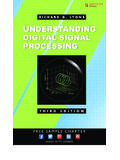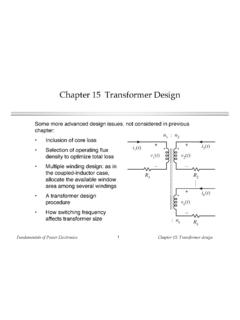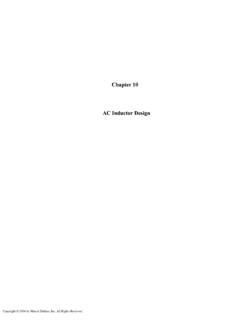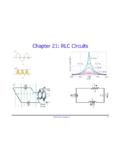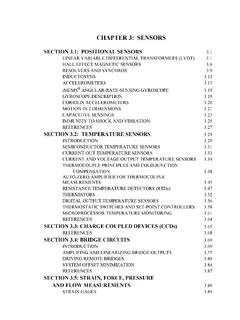Chapter 15 Transformer Design
Found 9 free book(s)Understanding Digital Signal Processing
ptgmedia.pearsoncmg.com9.3 Impulse Response of a Hilbert Transformer 487 9.4 Designing a Discrete Hilbert Transformer 489 9.5 Time-Domain Analytic Signal Generation 495 9.6 Comparing Analytical Signal Generation Methods 497 References 498 Chapter 9 Problems 499 10 SAMPLE RATE CONVERSION 507 10.1 Decimation 508 10.2 Two-Stage Decimation 510 10.3 Properties of ...
Chapter 15 Transformer Design
ecee.colorado.eduFundamentals of Power Electronics Chapter 15: Transformer design11 15.2 Step-by-step transformer design procedure The following quantities are specified, using the units noted: Wire effective resistivity ( -cm) Total rms winding current, ref to pri Itot (A) Desired turns ratios n2/n1, n3/n1, etc. Applied pri volt-sec 1 (V-sec)
Chapter 5 Protection Circuit Design - Fuji Electric
www.fujielectric.comtransformer • Low detection precision • Arm short-circuit ... protective circuit built in, thereby simplifying the drive circuit design. For more details, refer to Chapter ... 1200V 50A 15 max. 22 min. - 0.47 75A 4.7 min. * Chapter 5 Protection Circuit Design .
Appendix 9C: Design Calculations for Electrical Design
www.seattle.govChapter 9 Electrical Design Appendix 9C Design Calculations for Electrical Design SPU Design Standards and Guidelines November 2020 5 5.2 DIRECT CURRENT (DC) FORMULAS Basic Formulas Volts V = I x R Power in watts P V I P I R = × = 2 × 5.3 ALTERNATING CURRENT (AC) SINGLE PHASE V denotes line to neutral voltage. Basic Formulas Volts V =I ×Z
Chapter 10 AC Inductor Design - coefs.uncc.edu
coefs.uncc.edudesign. Magnetic materials and their operating flux levels are given in Chapter 2. The ac inductor like a transformer, must support the applied voltage, Vac. The number of turns is calculated from Faraday's Law, which states: 10' P, [turns] [10-7] KfB,,cfAc The inductance of an iron-core inductor, with an air gap, may be expressed as:
Highway Illumination Manual (HWI)
onlinemanuals.txdot.govAdditional information concerning circuit design and voltage drop was added. Chapter 8 - Temporary Lighting: Information covering method of payment for temporary lighting was updated. Chapter 9 - Construction and Maintenance Guidelines: Information on relocation of light poles was updated. Chapter …
Chapter 21: RLC Circuits
www.phys.ufl.eduPHY2054: Chapter 21 29 Transformers: Sample Problem ÎA transformer has 330 primary turns and 1240 secondary turns. The input voltage is 120 V and the output current is 15.0 A. What is the output voltage and input current? 1240 120 451V 330 s sp p N VV N ⎛⎞ == =⎜⎟ ⎝⎠ “Step-up” transformer iV iV pp ss= 451 15 56.4A 120 s ps p V ...
CHAPTER 3: SENSORS - Analog Devices
www.analog.comCHAPTER 3: SENSORS SECTION 3.1: POSITIONAL SENSORS Linear Variable Differential Transformers (LVDTs) The linear variable differential transformer (LVDT) is an accurate and reliable method for measuring linear distance. LVDTs find uses in modern machine-tool, robotics, avionics, and computerized manufacturing.
Chapter 5
pages.mtu.eduBasic principles The transformer may be considered as a simple two-wheel 'gearbox' for electrical voltage and current. The primary winding is analogous to the input shaft The secondary winding is analogous to the output shaft. In this comparison, current is equivalent to shaft speed and voltage to shaft torque. In a gearbox, mechanical power (speed multiplied by torque) is …
